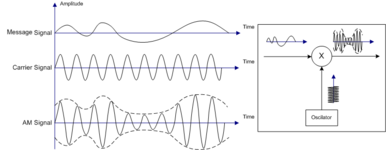neazoi
Advanced Member level 6
Hi,
According to wikipedia https://en.wikipedia.org/wiki/File:Illustration_of_Amplitude_Modulation.png when the audio is louder, one should see a higher level carrier on an Amplitude modulated transmitter.
But I have noticed on ham radio gears, that the other way is true.
For example in one of them, the idle carrier was 100W and the peaks when shouting to the microphone were 35W.
Which of the two is true, the carrier is reduced or increased on AM when the AF signal that is modulating it gets louder?
According to wikipedia https://en.wikipedia.org/wiki/File:Illustration_of_Amplitude_Modulation.png when the audio is louder, one should see a higher level carrier on an Amplitude modulated transmitter.
But I have noticed on ham radio gears, that the other way is true.
For example in one of them, the idle carrier was 100W and the peaks when shouting to the microphone were 35W.
Which of the two is true, the carrier is reduced or increased on AM when the AF signal that is modulating it gets louder?
